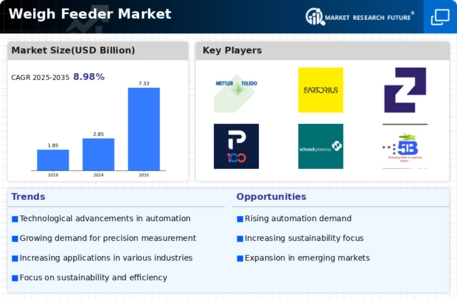Emphasis on Quality Control
Quality control remains a pivotal concern within the Weigh Feeder Market, particularly in sectors such as food and beverage, pharmaceuticals, and chemicals. The need for consistent product quality drives manufacturers to implement weigh feeders that ensure accurate dosing and blending of materials. This focus on quality is underscored by regulatory requirements that mandate precise measurements to meet safety and quality standards. As industries strive to enhance product integrity, the demand for advanced weigh feeder systems is expected to rise. Market analysis suggests that the quality control segment within the weigh feeder market could witness a growth rate of around 7% over the next few years. This trend indicates a robust opportunity for manufacturers to innovate and provide solutions that cater to stringent quality assurance processes.
Rising Demand for Automation
The Weigh Feeder Market is experiencing a notable surge in demand for automation across various sectors. Industries such as food processing, pharmaceuticals, and mining are increasingly adopting automated solutions to enhance operational efficiency. This trend is driven by the need for precise measurement and control of material flow, which weigh feeders provide. According to recent data, the automation sector is projected to grow at a compound annual growth rate of approximately 9% over the next five years. This growth is likely to propel the Weigh Feeder Market as companies seek to integrate advanced technologies that ensure accuracy and reduce labor costs. Furthermore, the shift towards Industry 4.0 emphasizes the importance of smart manufacturing, where weigh feeders play a crucial role in optimizing production processes.
Increasing Adoption of Smart Technologies
The Weigh Feeder Market is witnessing a significant shift towards the adoption of smart technologies, including IoT and AI. These technologies enable real-time monitoring and data analytics, which enhance the operational efficiency of weigh feeders. By integrating smart features, companies can optimize material handling processes, reduce waste, and improve overall productivity. The market for smart weigh feeders is projected to grow substantially, with estimates suggesting a potential increase of 10% annually. This growth is driven by the need for enhanced data visibility and control in manufacturing processes. As industries increasingly recognize the benefits of smart technologies, the Weigh Feeder Market is likely to evolve, offering innovative solutions that align with the demands of modern manufacturing environments.
Sustainability and Environmental Regulations
The Weigh Feeder Market is increasingly influenced by sustainability initiatives and environmental regulations. As companies strive to reduce their carbon footprint, there is a growing emphasis on efficient resource utilization and waste reduction. Weigh feeders contribute to these goals by ensuring accurate material measurement, which minimizes overuse and waste. Recent trends indicate that industries are investing in eco-friendly technologies, with a projected market growth of 8% in sustainable solutions over the next few years. This shift is likely to drive demand for weigh feeders that align with environmental standards. Furthermore, regulatory bodies are implementing stricter guidelines regarding emissions and waste management, compelling companies to adopt weigh feeders that support compliance. As a result, the Weigh Feeder Market is expected to expand in response to these sustainability pressures.
Growth in Construction and Infrastructure Development
The Weigh Feeder Market is poised to benefit from the ongoing growth in construction and infrastructure development. As urbanization accelerates, there is an increasing need for efficient material handling solutions in construction projects. Weigh feeders are essential for accurately measuring bulk materials such as cement, aggregates, and asphalt, which are critical in construction applications. Recent statistics indicate that the construction sector is expected to expand at a rate of 5% annually, thereby driving demand for weigh feeders. This growth is further supported by government initiatives aimed at improving infrastructure, which may lead to increased investments in construction equipment. Consequently, the Weigh Feeder Market is likely to see a corresponding rise in demand as companies seek reliable solutions to manage material flow effectively.


















Leave a Comment